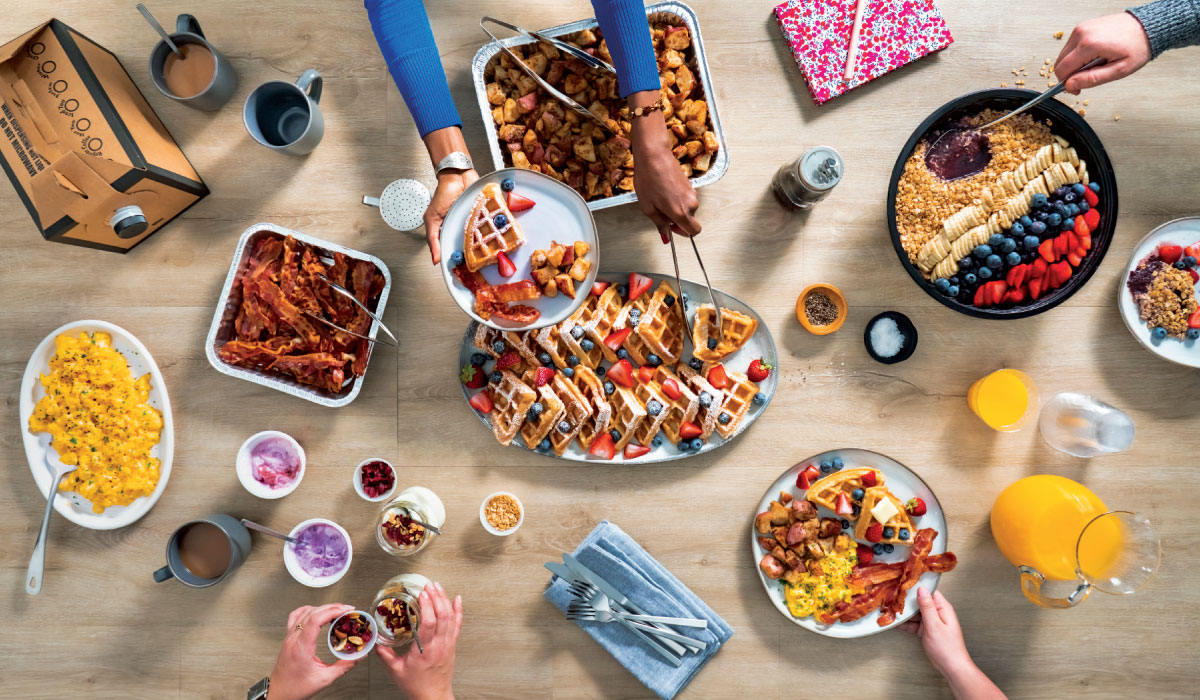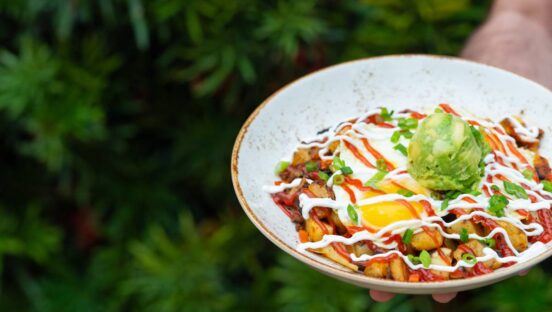












11. Don’t forget about email
Email is still one of the marketing world’s secret sauces: The average ROI for email marketing is $36 for every $1 spent. Many of the ideas above—catering, deals, gift cards, walk-away retail—should be included, if applicable, in a restaurant’s holiday emails.
Restaurants should use the holiday rush to build their email list for the rest of the year with new customer names and addresses. And it’s important to remember to always provide messages of value to customers; a frequency of once or twice a week should be all. Never over-message and risk getting labeled a spammer. While it’s the season of giving, spam isn’t the kind of offer anyone has in mind.
12. Put your holiday hours up–everywhere
Restaurants need their holiday hours updated on every mobile ordering app, in Google search results, in their email send-outs, and their storefront windows. Holiday meal specials should also be marketed through the same channels. Diners, who are leaving their home, should know what to expect when they get to an eatery during these special days with their families and friends.
Yet, every day should be seen as a chance for restaurant operators to help diners enjoy the holiday season while driving revenue. With this baker’s dozen worth of tips, they should find success throughout the season and the whole year.
Teddy Tsang is the Vice President of Product Marketing at Toast and owner/operator of Chaps Ice Cream in Charlottesville, Virginia.
1. Ramp up to-go
It’s already been a three-year trend: During 2019, 2020 and 2021, people often turned to takeout from a restaurant for their holiday dinner needs. And some in the media predict the trend will continue this holiday season. This shift in behavior should inspire restaurants to add to-go lanes in their stores and bolster discounted family meals and other offers.
And be creative with your to-go options. Consider holiday brunch and lunch specials or New Year’s Eve and Day packages for romantic couples, friends and families.
2. Lean into catering
Catering allows restaurants to reach people having holiday events with family and friends. In 2021, 29 percent of U.S. consumers planned to order catering for holiday celebrations, and 39 percent planned to host parties at a restaurant. Another 31 percent planned to host a work event at a restaurant.
This area will increase revenues year-round, too. Educational institutions, hospitals, and event organizers routinely hire caterers, so the service is not seasonal and extends across the calendar. All of those factors explain why brands such as Olive Garden, Chuy’s, and Red Robin have increased their focus on catering.
3. Anticipate digital check-splitting
People have long been tired of the idea of doing the math and awkwardly splitting the check with others. While friends and family tend to performatively argue over who is getting the bill, technology can make people more comfortable over the holidays by splitting up the cost fairly according to who got what.
POS screens and ordering apps allow diners to tap a few buttons to split up the check. In many cases, the table server designates seat numbers for each item, dividing up the check accurately. Given how folks grapple with splitting the check, and because they are getting familiar with the mobile features that are out there, expect more digital check-splitting than seen in past years.
4. Help staff earn more
Front-of-house employees depend on tips to support their families, and for many that’s exceptionally difficult during the holidays as expenses add up. Restaurant operators should use technology such as touch-screen POS systems to help increase servers’ gratuity income.
With the POS touchscreen, the restaurant operator or manager can set tip wages for the percentage they want. So, if the prepopulated tip percentages typically are 10/15/20/25 percent, they can be bumped up so the lowest option is 15 percent and the highest one is 30 percent. Servers will appreciate the gesture and the extra cash to spend on their loved ones.
5. Take care of your people
Due to the labor shortage, incentive programs are increasingly important for restaurants to keep their staffers. These programs motivate staff to work toward either personal or company goals and reward them with prizes. The holidays can be a great time to offer such prizes, which can be given out weekly or at the holiday party dinner in January.
The holiday party serves two purposes for restaurants, which typically hold their shindigs in January. Before the party, the upcoming celebration can psyche teams up for the busy stretch. For example, restaurants may want to invest in a party and book the event at a fun spot in town that your employees can get excited about. Then, the party will be their deserved reward for a job well done during the holidays.
6. Offer deals
Whether for in-person dining or take-out, restaurants may be offering more deals—sides, salads, desserts, and drinks to go with the main course—over the next few weeks. This idea happened last year at Thanksgiving, and it’s been building going into this holiday season.
Make sure the deals are loaded onto your POS and mobile ordering system. If someone orders a big meal on their phone but comes into the location to discover a deal they like better, that’s a frustrating customer experience because that information is too late and it’s an easily avoidable situation.
7. Plan ahead for inflation and supply chain issues
Inflation has impacted menu prices and will continue to do so during the holidays. So restaurant operators should research what neighboring eateries are charging to land on competitive and profitable menu prices.
The supply chain has also impacted restaurants. Operators should order their produce, meats, and dairy ahead of time, as it will be important to have all the ingredients you need to make the most popular dishes.
8. Sell gift cards
A truth we can all count on: People like to buy gift cards for others and themselves. Just last year, U.S. consumers spent more than half of their gift budget on gift cards, and more than 80 percent of people spent more than the gift card value when they redeemed it.
People also buy meals as gifts for the holidays. A National Restaurant Association study found 62% of consumers want a gift card to their favorite restaurant for the holidays. Restaurant operators receive immediate revenue for a gift card purchase, and it’s up to them to convert the diner into a regular. No matter what, the diner should be invited to join the restaurant’s loyalty program via an email address or cell number.
9. Use tech for smoother operations
Diners now often expect to interact with technology while having a meal. And tech such as mobile ordering kiosks and handheld devices can help make your busy holiday shifts more seamless for customers and more manageable for employees.
It can aid in generating smoother operations even if an eatery is short-staffed. A recent Toast study found that 1 in 3 restaurants have had a difficult time hiring this year.
10. Benefit from self-service features
More tech can not only lead to more seamless operations but also greater self-service options for diners. Take Zunzi’s, which has two popular sandwich restaurants in Georgia that are ready for the holiday rush.
Zunzi’s operators have begun utilizing mobile ordering at the table, kiosks for self-ordering, as well as handheld mobile tablets to allow the customer to order food based on their own preference. After implementing this technology, 75 percent of its orders now come from mobile ordering and kiosks, meaning the restaurant can run smoother with less staff doing the manual work of taking orders.
The Cost Equation
Many are looking for quick-and-easy fixes to their dinner needs for the holiday season. And due to inflationary grocery prices, more and more families and friends will be eating out or ordering takeout. It’s a trend that spiked during the 2021 holidays and has again shown up in recent weeks.
Eating out is simply more economical for some consumers compared to years past, as holiday dishes at restaurants could be priced similarly to what one could make in their kitchen. A November report from Wells Fargo found grocery prices are rising at a faster clip than hospitality food. And Consumer Price Index data for food at home has gone up 12 percent since November 2021, compared to 8.5 percent for food away from home.
Indeed, emerging consumer behavior and economic factors suggest that the holidays can provide restaurants with a revenue spike. With that in mind—and in the spirit of the old English carol, “The Twelve Days of Christmas”—let’s look at a dozen tips for restaurants as they prepare for holiday customers.










